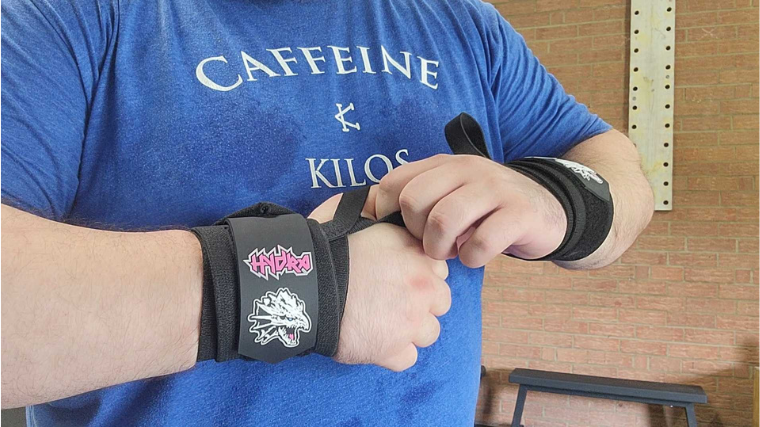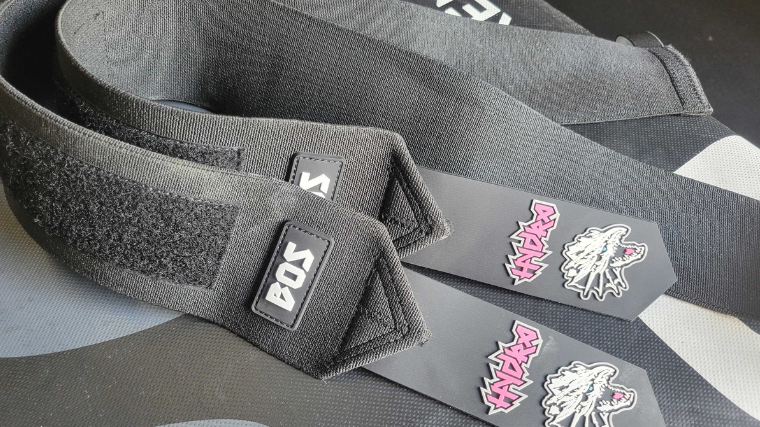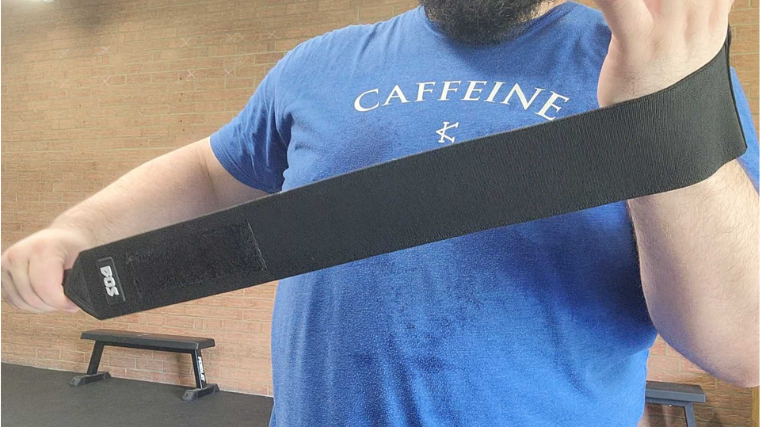Wrist wraps are functional pieces of supportive strength gear for lifters who want additional wrist support when training. Traditionally, lifters wear wrist wraps to alleviate pressure on the wrists during longer workouts or when performing heavy lifts. On the bench press, wrist wraps support barbell security. When using a mixed grip for a deadlift, wrist wraps help prevent losing the barbell due to it spinning out.
Wrist wraps come in a wide variety of styles. Some have a wider width to support the full wrist, while others are thinner to support a specific section of the wrist, and allow for greater mobility of the joint. Other wrist wraps are made with thicker or stiffer material to give maximum support when handling heavy weights. They also have different fastening mechanisms (with the most common being velcro), but some use buckles like a belt, or tie like shoelaces. We’ve tested and reviewed many different options, and found the best wrist wraps on the market for various activities. If you’re a fitness enthusiast trying to improve your performance, but your wrist support is lacking, then it might be time to invest in a new pair of wrist wraps.
The Best Wrist Wraps of 2025
- Best Wrist Wraps: Gymreapers Wrist Wraps
- Best Wrist Wraps for Weightlifting: Bells of Steel Mighty Wrist Wraps
- Best Leather Wrist Wraps: Element 26 IsoWrap Wrist Wraps
- Best Wrist Wraps for Beginners: DMoose Wrist Wraps
- Most Durable Wrist Wraps: Manimal Wrist Wraps
- Best Wrist Wraps for Powerlifting: Gymreapers Wrist Wraps (Stiff Heavy Duty)
- Best Neoprene/Foam Wrist Wraps: Rehband RX Wrist Wrap Support
Best Wrist Wraps: Gymreapers Wrist Wraps
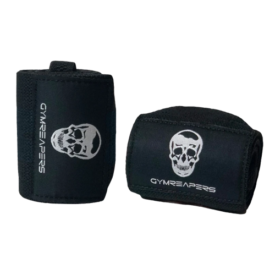
These wraps are three inches wide and made of high-grade nylon (30 percent elastic and 70 percent polyester). At 18 inches long, these wraps are long enough to offer solid wrist support.
Specs
- Wrap length: 18 inches
- Material: Nylon and polyester
- Price: $19.99
Pros
- This is a durable wrist wrap with reinforced stitching.
- These offer pretty heavy wrist support.
- Gymreapers included a heavy-duty thumb loop that will last instead of ripping off with just a few uses.
Cons
- Wrist wraps made with a softer material, such as cotton, may be easier on the skin than these nylon wraps.
- These wrist wraps are not machine washable.
- Athletes who prefer a more minimal wrist wrap may want to look at other options on this list.
When searching for the best wrist wraps, they should check all the right boxes — durable, secure, easy to use, and comfortable. We think Gymreapers Wrist Wraps easily take the top slot here.
Wrist wraps in particular serve a variety of different purposes depending on your sport. For regular gymgoers, they add a bit of comfort to the wrists, and can help prevent injury. For powerlifters or strongman competitors, they serve as a vital piece of gear to help protect and reinforce the wrists during heavy pressing. We’ve even seen them used to help improve grip on things like deadlifts and carrying events in strongman.
Strength athletes and enthusiasts who want a flexible, well-built wrist wrap across various workouts are likely to find Gymreapers to be an ideal fit. They are three inches wide and made of high-grade nylon (30 percent elastic and 70 percent polyester). At 18 inches long, these wraps are long enough to offer sufficient wrist support. Most wrist wraps should limit movement enough to ensure that wrists aren’t exposed to injury — Gymreapers fall into that camp, but they don’t limit the wrist so much that there isn’t any flexibility.
The reinforced stitching and elastic in these wrist wraps provide an excellent combination of durability and flexibility. No matter your strength sport, these wrist wraps can help protect your wrists without hindering your movement patterns. Even if squats are part of a training session, they can offer enough comfort in the movement to hold the barbell without limiting support.
Although these wraps might feel a bit tougher on the skin than comparable options on the market, they will still allow for sufficient mobility in training. Again, beginners who are on the lookout for a pair of wrist wraps with a thumb loop may need to search elsewhere, but any serious strength athlete could benefit from placing Gymreapers Wrist Wraps at the top of their buy list.
Read our full review of the Gymreapers Wrist Wraps.
Best Wrist Wraps for Weightlifting: Bells of Steel Mighty Wrist Wraps
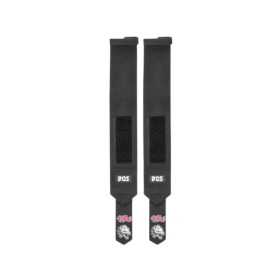
Minimize wrist pain through your heavy lifts with these wrist wraps that come in two different lengths and several designs to suit your aesthetic. The competition wraps are thicker for more stability and support while the training wraps are thinner for added comfort and flexibility.
Specs
- Wrap length: 20 and 27.5 inches
- Material: Polyester and elastic
- Price: Starting at $29.99
Pros
- Thicker wraps for more support
- Choose flexibility or added support with different lengths
- Multiple styles to choose from
Cons
- Not approved for IPF or IWF competition
- Wraps can get overly tight
- Polyester can be less durable than Nylon
Whether you’re throwing the best barbells around or doing pushups during commercial breaks while you watch tv, adding some reinforcement to your wrists can help you PR without pain. The Bells of Steel Wrist Wraps are our choice of the best wrist wraps for weightlifting after our tester spent two weeks training Olympic lifts and powerlifts with them on.
You can choose the amount of support and flexibility you’d like, depending on your experience and the types of weightlifting you’ll be doing, by opting between 20 and 27.5 inch lengths. “The wraps are super supportive, but I was still still able to move around for cleans and snatches,” says our tester, with an overall experience score of 4.5 out of 5. “However, they did occasionally feel a little too tight, so I needed to readjust between sets.”
Unlike typical wrist wraps that are made out of nylon or leather, these weightlifting wraps are made from polyester and elastic. While polyester can be less durable than Nylon, our tester is impressed with how these held up throughout their gym session. “I’ve used a handful of wrist wraps over the years, and these thick wraps feel like the studiest ones I’ve ever tried,” says our tester, scoring functionality a perfect 5 out of 5.
Adjustments scores a 5 out of 5, as well. “The wraps have a thumb loop to help hold one end in place while you wrap up,” says our tester. You can choose between 20 and 27.5 inches in length, or opt for competition or training style, depending on the amount of support and flexibility you’re after. Additionally, there are three design options so you can add some style to your routine.
While not approved for IPF or IWF competition, these wraps will still do you well whether you’re cleaning, jerking, or working on your snatch pull in your gym or from the comfort of your own home.
Best Leather Wrist Wraps: Element 26 IsoWrap Wrist Wraps

These wrist wraps are made with cotton or suede leather and are designed to support the scaphoid bone. They have a width of one inch and a length of 33 inches.
Specs
- Wrap length: 33 inches
- Material: black suede leather
- Price: $24.97
Pros
- Suede leather feels good on skin
- Thin design allows for mobility
- Targeted support for the scaphoid bone
Cons
- May be too thin for larger wrists
- May not be best for those recovering from a wrist injury
Leather wrist wraps have an old-school vibe to them that just feels objectively cool. Element 26 took the old-school nature of leather wraps and put a modern twist on it with suede, which can feel more comfortable than typical leather wraps and allow for more freedom of movement. There’s something satisfying about the feeling of leather lifting gear — whether it’s the best weightlifting belt or wrist wraps, it just feels… good. Leather can also potentially offer more longevity than other materials if you care for it properly.
Leather wraps tend to measure 3-inches wide to help take stress off your joints, but this size can limit wrist mobility. Element 26 made their suede leather IsoWrap Wrist Wraps just one inch in width, allowing for more movement in the wrist, and built to help support the exact spot on the wrist that they say needs the most support — the scaphoid bone.
The scaphoid bone (a bone in the wrist on the side closer to the body) is targeted with the one-inch design to supply support and allow for enhanced flexibility. This flexibility can be valuable during a wide-grip snatch to ensure there isn’t too much pressure on the thumb. Additionally, it can also allow for better comfort when performing hang snatches.
Their narrow width doesn’t impede wrist mobility, so you can use these wraps for Olympic lifts with confidence, but they may not be the best choice for lifts where you want a lot of support (like you would with bench press or heavy squats) or for those with larger wrists. Similarly, if you’re recovering from a wrist injury, you may want a wider wrist wrap for added support and stability.
[Related: Strength Athletes: Don’t Overlook Your Wrists]
Best Wrist Wraps for Beginners: DMoose Wrist Wraps

These wrist wraps are made with a breathable cotton fabric and durable velcro, so they won't shift around during your workout. Plus, they come in an array of unique colors and designs.
Specs
- Wrap length: 12 inches and 18 inches
- Material: Cotton-elastine blend
- Price: Starting at $15.99
Pros
- Comfortable fit ideal for beginners
- You can choose from 12 unique color/design options
- These come in two length options, 12 inches and 18 inches
Cons
- May need to be washed more often than others
- Thumb loop can be uncomfortable or stretch out
We’ve all been beginners at one stage in our fitness journey, and when you’re first starting out, you’re likely sticking with the basics when building workout programs and lifting moderately light weights to learn the proper technique before you advance. If this is the case for you, you may want to start out with a more comfortable and flexible fit that offers lighter wrist compression like the DMoose Wrist Wraps.
Some of the wrist wraps designed for serious athletes can be a little rigid and uncomfortable, so finding a supportive pair that are also comfortable is usually a good bet for beginners. These wraps are likely to fit that bill as they’re constructed out of a cotton-elastane blend that’s soft and flexible. However, while Cotton is breathable, it will also absorb more sweat so you may need to give these a wash more frequently than other wrist wraps.
While the thumb loop is a nice addition for beginners, making it easier for new users to position the wraps properly, it can be uncomfortable and can stretch out after repeated use. “The wrist bands are perfectly fine, but I find the thumbs straps are uncomfortable and perhaps should be made wider,” says a customer review on Amazon. Similarly, other reviews mentioned these thumb loops stretching out after repeated use.
If you don’t know how to use wrist wraps properly, these can be tightened via velcro into a secure position. You’ll have two length options, either 12-inches or 18-inches, depending on how much support you want on your wrists. Plus, 12 unique color designs to add some flair to your workout gear.
For all the reasons that our picks farther up on this list are better suited for advanced lifters, the opposite is true for beginning lifters. The elastic material, velcro fit, and thumb loops are useful for an athlete who needs to learn how to lift properly with wraps and who is finally lifting heavy enough that wraps are needed.
Most Durable Wrist Wraps: Manimal Wrist Wraps
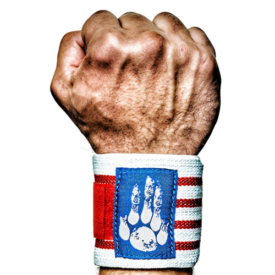
Lift long and lift strong with these incredibly stable wrist wraps. Offering a solid blend of comfort and wrist support, Manimal wrist wraps also come with a lifetime warranty.
Specs
- Wrap length: 17.5 inches
- Material: Elastic, nylon, cotton blend
- Price: $35.00
Pros
- Lifters who want durable, heavy-duty wrist wraps will appreciate that these wraps are intentionally overbuilt to withstand punishment.
- The heavy-duty velcro and reinforced thumb loop allow you to pull these wraps as tight as you like.
- There are nine colorways ranging from black to red, white, and blue.
Cons
- These may inhibit mobility in exercises that typically require wrist flexibility.
- Manimal makes these wrist wraps to be pretty stiff. Gymgoers looking for a lighter level of wrist support should look elsewhere.
- Wrist wraps with a narrower width may better support some people who don’t want wide wraps.
Wrist wraps are pieces of gym equipment that may be used in nearly every session in some capacity (and usually under a heavy load). With that type of frequency and harshness of use, it’s important to get a pair of wrist wraps that you know will stand up to the challenge. These wrist wraps have been around for years, and we are confident in their durability.
No matter what you throw at them the quality and durability of Manimal Wrist Wraps seem to hold up lift after lift, PR after PR. The superior velcro and purposefully overbuilt materials allow normal wear and tear to take its toll without having an effect on the performance of the wrist wraps. Manimal took over a year to develop these wraps to their high standards of durability. These are a solid pick for those who train the big three — heavy deadlifts, high-rep bench presses, and squats — or frequently train accessory exercises (we also like them for kettlebell work).
A nice feature of these is that they’re designed to fit on either wrist — left or right — so you can just pull them out, strap them on, and go without fumbling around trying to figure out which one goes on which wrist. Manimal also offers a lifetime warranty against defects and quality issues. These wraps may be priced higher than some others on this list, but Manimal states that their wraps last an average of two years or longer with proper maintenance, providing great value for your money.
If you’re hitting it hard in the gym, and want a pair of wrist wraps that can stand the test of time and absorb a lot of abuse, the Manimal wrist wraps might be for you. Their reinforced stitching and overbuilt nature make them a go-to for those who desire the most support they can get from their wrist wraps.
Best Wrist Wraps for Powerlifting: Gymreapers Wrist Wraps (Stiff Heavy Duty)
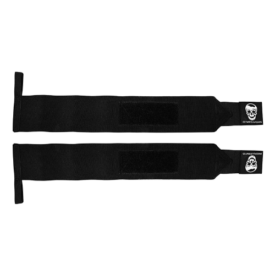
The thumb loops on these straps are reinforced, and they are 18 inches in length. They're also competition grade, and made from upgraded and reinforced elastic to be stiffer than other wraps on the market.
Specs
- Wrap length: 12, 18, or 24 inches
- Material: High-grade elastic material
- Price: $29.99
Pros
- Gymreapers makes these wraps in a variety of sizes from 12 to 24 inches.
- The rigid material makes these good for people who are serious about competing in powerlifting.
- The construction offers much stiffer material with reinforced stitching, which is much stronger than what you’ll find with regular wraps.
Cons
- These wraps’ stiffer and thicker material make it so that they aren’t as flexible for Olympic lifts.
- If you want lighter support you may want to look elsewhere.
- These can get uncomfortable with prolonged wear due to the stiffness of the material.
Many powerlifters rely heavily on wrist wraps, and put them through some of the most punishment of any athlete. That’s why powerlifters need the most support possible when it comes to their gear. When you’ve got a heavy bench press sitting over your chest, the last thing you want is your gear failing. That’s why our top pick for best wrist wraps for powerlifters is Gymreapers Wrist Wraps (Stiff Heavy Duty).
Gymreapers designed these wrist wraps with the competitive powerlifter in mind. Every detail is meant to improve stability, provide confidence, and help you blast through even the heaviest bench sessions. The thumb loops are reinforced, so they won’t fall apart after one use, and this product has a lifetime replacement guarantee.
These 18-inch wraps are competition grade, and made from upgraded and reinforced elastic to be stiffer than other wraps on the market. If you’re serious about lifting some heavy weights and want maximum support for your wrists, then these are the wrist wraps for you.
The only real knock against these wrist wraps is that they might support the wrists too well for some athletes. If you’re looking for wrist support to train the big three lifts specifically, we think these wraps check all of the boxes. However, if you need wrist wraps with less rigidity, another option on this list may be better for you.
[Related: The Lifter’s Guide To Magnesium: What This Nutrient Does For Strength]
Best Neoprene/Foam Wrist Wraps: Rehband RX Wrist Wrap Support
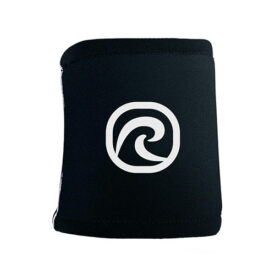
These sleeves are made of five-millimeter thick SBR-neoprene foam material (70 percent SBR, 30 percent neoprene) with a 100-percent polyamide cover and lining. The flexible design offers compression and warmth to help with wrist stability.
Specs
- Wrap length: 5.9 inches to 8.66 inches
- Material: Neoprene
- Price: $21.99
Pros
- These wrist wraps are comfortable and provide light support and warmth for training.
- The compression aspect can be helpful for rehabbing a wrist injury.
- You can slide these wraps on and off easily, cutting down on the time it takes to wrap your wrists.
Cons
- There is no way to adjust the compression that these wraps offer manually.
- The sleeve design slips on over the wrist rather than being wrapped around it and fastened with velcro or tied down, so it provides less compression than other wraps.
Some folks don’t want or need a lot of wrist support when they’re lifting. But it may still be nice to have something there to aid in keeping the wrist joint warm or provide an extra boost of confidence. That’s where this category of wrist wraps comes in. More similar to a knee sleeve that you wear on the wrist than a traditional wrist wrap, these add light compression, and some warmth when lifting.
These wrist wrap supports are more akin to sleeves than to more traditional wraps. Each wrist sleeve is 3.5 inches wide, five millimeters thick, and has a foam construction that is 70 percent styrene-butadiene rubber (SBR) and 30 percent neoprene. The cover and the lining are fully polyamide and can provide some compression and warmth to the wrists during training. These wrist wrap supports are ideal for someone who wants to have some warmth on the wrist joint without sacrificing any mobility at all. The 5mm thickness is thick enough to provide a little support and warmth, but thin enough to avoid bunching or getting in the way when trying to turn over a clean or punch out a snatch.
These can also be worn over top of other, more traditional wrist wraps to provide a smoother surface to glide against the skin when performing different movements. In addition to providing some wrist support, these double as sweat bands since the material used is more absorbent than other wrist wraps. One downside of these is that they are only available in black, so if you like different colors to choose from, you may want to look at another option.
These wrist wraps were developed to provide an alternative to the traditional style of wrist wraps that dominates the market. They slip on over the hand and wrist to provide light support, as well as some warmth and stability. These wraps can even be used as an accessory for wrist rehab work.
Benefits of Wrist Wraps
Wrist wraps are extremely common and popular among fitness enthusiasts of all types and levels. They can provide support when handling heavy loads to help improve the rigidity of the kinetic chain of the arm. They’re also useful for potentially helping to prevent injury and may be used when returning from an injury for extra protection of the wrist joint.
Improve Form and Technique
This is the obvious reason that most people utilize wrist wraps — support for improved technique and form. When worn properly, wrist wraps may help to improve the stability and rigidity of the hand-to-forearm area, making for a more stable base to press from to potentially improve your form. Along with a more solid wrist area, there is less pressing power lost due to lack of stability when wearing wrist wraps, allowing you to generate force in a more direct linear fashion rather than horizontally due to wrist movement. (1)
Injury Prevention and Rehabilitation
“Barbells are for anyone and everyone interested in strength training, any type and for any reason,” says BarBend expert reviewer Amanda Capritto, a certified personal trainer. But if you’ve had wrist problems in the past — or just want some added stability — you may want to approach the bar with a few safety accessories, including wrist wraps.
Wrist wraps may help prevent injury to not only the wrist but also the rest of your body. It’s a common sight to see powerlifters or strongman competitors squatting with wrist wraps on to help prevent excess strain on their wrists. Likewise, the improved stability that wrist wraps may provide might help prevent a barbell from slipping during a bench press due to a wrist giving out.
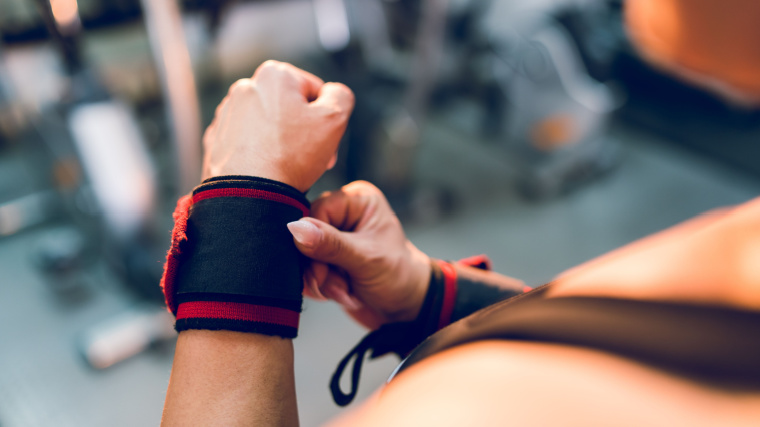
Injury rehabilitation is a somewhat less common reason for wearing wrist wraps. That said, wrist wraps can be a potentially useful tool by providing some extra support to the lower forearm and wrist, depending on the placement and wrapping style. (2)
Pain Relief
Anecdotally, many lifters claim to have improved grip strength and less forearm pain when dealing with an injury in that area. (2) The potentially reduced stress on your wrists may help alleviate pain that could arise form instability in the joint. Additionally, the compression of wrist wraps may aid in pain relief.
How We Chose the Best Wrist Wraps
We take many factors into consideration when making picks for these lists. There are different materials the wraps are constructed from, different securing mechanisms to lock them into place, and different price points. Durability is also an important factor in deciding if a wrist wrap will make the list. Wrist wraps also need to be flexible and able to work for a variety of exercises since most people won’t be walking around with multiple pairs of wrist wraps in their gym bags. We know you want the best value for your money, so we take all of these factors into consideration.
Construction
Wrist wraps are simplistic in nature, which makes the construction that goes into them important. When assessing construction we look at four critical parts of wrist wraps, including:
- Main material
- Velcro, buckles, or other tightening mechanisms
- Thumb loop
- Reinforced stitching
The main material is the most critical component because this is what largely provides additional wrist support. Ideally, you want a blend of materials that allow the wrist wraps to remain supportive and stretch to some degree. This allows you to dictate their tightness without the material limiting performance.
The velcro and thumb loop is also important construction characteristics to consider. The thumb loop needs to be strong because it often endures a lot of pressure. If it’s poorly constructed, then it could fray and disconnect. In addition to the thumb loop, the velcro used is also important to consider. Ideally, lifters want a velcro that is wider and spans a few inches. This type of construction optimizes durability, security, and surface area.

Stitching, the final characteristic we assess, is somewhat self-explanatory as to why durability is important. Double and triple stitching can help prevent material from ripping due to stretching regularly.
[Related: How to Do the Romanian Deadlift]
Flexibility
The flexibility offered by a pair of wrist wraps is likely decipherable via their length and the material they are made with. Are the wrist wraps designed for smaller wrists, more advanced athletes, or a specific activity like kettlebell snatches, thrusters, or Bulgarian ring dips? The flexibility a pair of wrist wraps allow without conceding support is critical to help prevent injury while providing the necessary support.
For routine gym-goers looking for some additional wrist support while circuit training on weight machines, nylon or some other elastic material will likely suffice. More advanced athletes who compete or lift much heavier are probably better suited with a pair of wrist wraps made of leather or some other tough material and/or have reinforced stitching of some kind.
What Type of Lifting Are You Doing?
Throughout the list, we offered what we consider to be the best wrist wraps for a variety of strength sports and stages of the fitness journey. That said, you should take a look at the type of lifting that you predominantly do, and match your gym gear according to that. If you’re into weightlifting, then a heavy-duty wrist wrap that limits mobility might not be best for you.
Conversely, if you’re a powerlifter, a light wrist wrap that offers great wrist mobility but only moderate support likely won’t cut it when you’re hitting a new bench press PR. The best way to figure out what type of wraps to buy is to look at what you’re doing in the gym, and what the needs of your wrists are during those movements. Sometimes, you may need to carry two pairs, or even three pairs of wraps with you, depending on the type of workout you’re doing that day.
When should you use wrist wraps?
This is really a personal choice, but we recommend using wrist wraps for your last warm up set or two, along with your working sets. If you’re trying to build up to a one-rep max, then you may want to put them on earlier in your warm up to not tax the wrist tendons and ligaments so much during your warm up sets. Some people wear their wrist wraps throughout their entire workout, and some people just put them on when they’re about to perform a set. It’s really a personal preference, so try out a variety of ways of wearing them during your workouts, and see what works best for you.
[Related: The Best Lifting Straps You Can Buy]
How Much Do Wrist Wraps Cost?
Wrist wraps come in many shapes and sizes, though the price range for them is relatively narrow. A high-quality set of everyday-use wrist wraps will set you back somewhere between $16 and $35. There are some cheaper options out there, but they’re generally not as well-made and may not stand up to repeated use, so we didn’t include any of those on this list — you’ll find only top-notch support gear here.
| Best Wrist Wraps | Gymreapers Wrist Wraps | $19.99 |
| Best Wrist Wraps for Weightlifting | Bells of Steel Mighty Wrist Wraps | $29.99 |
| Best Leather Wrist Wraps | Element 26 IsoWrap Wrist Wraps | $24.97 |
| Best Wrist Wraps for Beginners | DMoose Wrist Wraps | Starting at $15.99 |
| Most Durable Wrist Wraps | Manimal Wrist Wraps | $35 |
| Best Wrist Wraps for Powerlifting | Gymreapers Wrist Wraps (Stiff Heavy Duty) | Starting at $16.99 |
| Best Neoprene/Foam Wrist Wraps | Rehband RX Wrist Wrap Support | $19.99 |
People who may need some extra support or those who are looking for extra long wrist wraps may have to drop a bit more money to accommodate their needs — sometimes upwards of $50. Leather wrist supports with buckles can cost more money sometimes too, though those are usually more popular among elite weightlifters whose wrists need all the support they can get.
How to Choose the Best Wrist Wraps for You
Just as when shopping for anything, there are some major things to consider before pulling the trigger and actually making a purchase. Each piece of equipment comes with its own unique set of considerations, and wrist wraps are no exception. We listed some of the most common things to consider before buying your first or next pair of wraps.
How the Wrist Wraps Are Made
When sifting through the many wrist wrap options on the market, we suggest you consider how the wrist wraps are constructed. Yes, they’re simple in nature, but the way they’re made matters for support. The main materials used in wrist wraps are elastic and cotton, or a polyester/cotton blend. This allows them to be stretchy but still rigid enough to provide support. This type of wrist wrap is usually fashioned together with velcro to hold them in place when they’re put on.
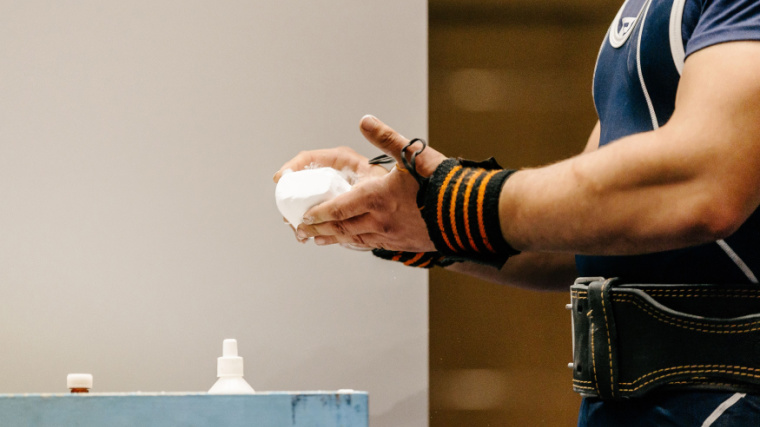
Some wrist wraps are still made from leather with buckles, like that of a belt, to keep them on. Further and more rarely, wrist wraps are made from some sort of canvas material, and tied together with a shoelace-like string to stay on — these are more popular among CrossFit and weightlifting communities and rarely used outside of them.
Versatility
You’ll also want to consider the versatility of the wrist wraps, and if they are best for your style of workout. Certain wrist wraps are designed with a specific type of lifting in mind and are going to work best for that type of lifting. Other wrist wraps are made to be more universally useful and to support the wrist in general. More on that below.
What Type of Lifting You Do
The final key point is one that you need to decide for yourself — what type of lifting do you do, or want to do? Figuring that out will aid you in making your decision about which wrist wraps to buy. You may even need to grab a few different pairs to experiment until you find what works best for you, individually.

[Related: Thoracic, Arm, And Wrist Mobility Checklist For The Overhead Squat]
If you’re a competitive weightlifter, odds are you aren’t going to opt for the super stiff powerlifting wrist wraps, unless, of course, you’re nursing a wrist injury or something of the sort. Likewise, a powerlifter isn’t going to want a pair of one-inch wrist wraps made to keep the wrist flexible, and provide just some support — they’ll generally want maximum support when going for a new PR. Whether you’re a beginner or an advanced lifter, you always want to take an inventory of why you’re purchasing this piece of equipment, and what you expect to get out of it before making any decisions.
Final Word
There are many different styles of wrist wraps to choose from, and an equally varied number of materials they can be made from. Figuring out which type is best for you comes down to thinking about what your lifting goals, are and what you’re looking to get out of this specific piece of equipment.
Wrist wraps are useful for lifters who want an additional level of support around their wrists when working out. Some fitness enthusiasts like to use wrist wraps for maximal days, while others like general support. When finding your perfect pair, let this list be your guide to the best choice.
Wrist Wraps FAQs
What are the best wrist wraps?
Finding the best wrist wraps for you may take some experimenting with different types, lengths, stiffnesses, and so on. That said, a great place to start, and our favorite at the moment, is the Gymreapers Wrist Wraps. They’re supportive without being restrictive and priced affordably. The reinforced stitching and high-quality velcro make them a solid option for beginners and advanced lifters alike.
How long do wrist wraps last?
Since wrist wraps aren’t made from adamantium, they will eventually wear out and need to be replaced. Leather ones will last longer — a few years even — especially ones with buckles instead of velcro. Cotton and elastic wraps usually tap out at around a year when the velcro and elasticity fail.
What are wrist wraps for?
Wrist wraps are meant to provide support for your wrist when performing pressing exercises in the gym or any exercise that puts strain on the wrist like certain yoga poses. Some people also use wrist wraps to potentially aid with grip strength during deadlifts or rows.
How do I put on a wrist wrap?
Start with your thumb in the aptly named thumb loop and then wrap comfortably tight around the wrist until the velcro is attached. For extra support with longer wrist wraps you can use an X pattern around your wrist similar to knee wraps.
How much do wrist wraps cost?
Thankfully, the price range for wrist wraps is relatively small compared to other, larger pieces of gym equipment. You can score any of the high-quality and durable pairs of wraps on this list for between $16 and $35. Some specialized wrist wraps may cost more, upwards of $50, but they’re for use in specific scenarios and most people can use the options on this list and be perfectly fine.
Will wrist wraps make my wrists weak?
When used properly and worn only when needed, wrist wraps might actually help strengthen your wrists by allowing you to handle heavier weights with more stability. That said, you have to be honest with yourself, and know if you’re using the wrist wraps as a crutch to make up for weak wrists that you already have and should be working on. At the end of the day, wrist wraps are a piece of equipment, and are only as beneficial or detrimental to your gains as the way you use them.
How should I care for my wrist wraps?
We always recommend caring for your wrist wraps in compliance with what the manufacturer suggests. If you can’t find that information or don’t feel like looking it up, our preferred method of caring for our wrist wraps is to fill a sink with warm soapy water, and soak them in it for about fifteen minutes. After the time has elapsed, remove the wraps and rinse them with warm water to get the soap out. Hang to dry. You should clean them regularly, but some people will have to wash them more often than others, depending on how much you sweat. A good rule of thumb is to clean your gear every other week to prevent smell and bacteria from building up. No friend wants nasty-smelling wrist wraps that haven’t been cleaned since you bought them when they’re spotting you.
References
- Coutinho, M. (2022). The Wrist wrap as a protective and performance enhancing device in powerlifting.
- Harris, D. R., Cardaci, T. D., Cintineo, H. P., Pham, R. D., Dunsmore, K. A., Funderburk, L. K., & Machek, S. B. (2022). The Prevalence of Wrist Wrap Use in Actively Competing Powerlifters. In International Journal of Exercise Science: Conference Proceedings (Vol. 2, No. 14, p. 149).

